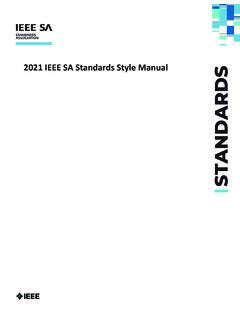Transcription of Engineering Working Drawings Basics - NASA
1 MENG 204 - Mechanical Drawing Lecture Notes by: Dr. Ala Hijazi Engineering Working Drawings Basics Page 1 of 22 Engineering Working Drawings Basics Engineering graphics is an effective way of communicating technical ideas and it is an essential tool in Engineering design where most of the design process is graphically based. Engineering graphics is used in the design process for visualization, communication, and documentation. Graphics is a visual communications language that include images, text, and numeric information. Graphics communications using Engineering Drawings and models is a clear and precise language with definite rules that must be mastered in order to be successful in Engineering design.
2 Graphics communications are used in every phase of Engineering design starting from concept illustration all the way to the manufacturing phase. An Engineering (or technical) drawing is a graphical representation of a part, assembly, system, or structure and it can be produced using freehand, mechanical tools, or computer methods. Working Drawings are the set of technical Drawings used during the manufacturing phase of a product. They contain all the information needed to manufacture and assemble a product. Codes and Standards Codes and standards are made to organize and unify the Engineering work. Imagine; what if there was no standard for bolts?
3 A code is a set of specifications for the analysis, design, manufacture, and construction of something. A standard is a set of specifications for parts, materials, or processes intended to achieve uniformity, efficiency and specific quality. Examples of the organizations that establish standards and design codes: ISO , AISI, SAE, ASTM, ASME, ANSI, DIN. There are many different standards related to technical Drawings . The ISO standards for technical Drawings are found in a two volumes handbook: ISO Standards Handbook: Technical Drawings , Volume 1: Technical Drawings in general ISO Standards Handbook: Technical Drawings , Volume 2: Mechanical Engineering Drawings ; Construction Drawings ; Drawing equipment MENG 204 - Mechanical Drawing Lecture Notes by: Dr.
4 Ala Hijazi Engineering Working Drawings Basics Page 2 of 22 Drawing Sheet layout Standard layouts of drawing sheets are specified by the various standards organizations. The figure shows the layout of a typical sheet, showing the drawing frame, a typical title block, parts list (bill of materials) and revision table. Sheet Frames It is standard practice for a drawing frame to be printed on each sheet, defining a margin around the outside of drawing area. The margins of the drawing frames are standardized for each size of paper. MENG 204 - Mechanical Drawing Lecture Notes by: Dr. Ala Hijazi Engineering Working Drawings Basics Page 3 of 22 The standard sizes of drawing frames for ISO sized sheets, with no filing margins, are as shown in the table: Title Block, The title block is normally placed in the bottom right of the drawing frame, and it should contain the following information.
5 The name of the company or organization the title of the drawing the drawing number, which is generally a unique filing identifier the scale the drawing size the angle of projection used, either first or third, generally shown symbolically the signature or initials of the draftsman, checker, approving officer, and issuing officer, with the respective dates the material of the part the revision number the sheet number for multi-sheet Drawings other information as required (tolerances, surface finish, etc.) In addition to the information above, for Drawings produced using CAD software, it is highly recommended to have the following information in the title block: the name of the CAD software used and its version the name of the drawing file the name of the source part or assembly file the units of the dimensions (if the drawing is mistakenly printed on a different paper size, the scale becomes meaningless) Revision Table, A revision table is normally located in the upper right of the drawing frame.
6 All modifications to the drawing should be documented there. Material or Parts List (Bill of Materials), If the drawing contains a number of parts, or if it is an assembly drawing, a tabulated parts list is added to the drawing. The bill of materials is usually placed at the bottom right of the drawing frame, just above the title block. MENG 204 - Mechanical Drawing Lecture Notes by: Dr. Ala Hijazi Engineering Working Drawings Basics Page 4 of 22 The bill of materials should give the following information: the part number the part name the quantity required material specifications the drawing number of each individual part other applicable information When the parts list is very large a separate drawing sheet may be used for the parts list alone.
7 Zoning, A drawing may be divided up into a grid using letters and numbers. When zoning is used it is located inside the drawing frame. Zoning is usually used for large size drawing sheets where it allows easy references to various parts of the drawing by referencing a coordinate such as B4. Notes, Information other than pictorial views and dimensions necessary for completing a drawing is classified as notes . Notes are usually placed in the lower left corner of the drawing sheet and they are numbered consecutively downward. Some examples of the notes used in Working Drawings are as follows: Dimension Notes ALL DIMENSIONS APPLY AFTER SURFACE TREATMENT.
8 Heat Treating Notes HEAT TREAT IN ACCORDANCE WITH standard-XXX TO XXX-hardness Joining Method Notes (welding, brazing, etc.) FUSION WELD IN ACCORDANCE WITH standard-XXX Plating and Coating Notes CADMIUM PLATE IN ACCORDANCE WITH standard-XXX Surface Preparation Notes SURFACE TO BE CLEANED AND POLISHED FOR VACUUM USE. Testing and Inspection Notes RADIOGRAPHIC INSPECTION OF ALL WELDS IN ACCORDANCE WITH standard-XXX Threaded Inserts Cleaning and Installation Notes TIGHTENING TORQUE OF THREADED FASTENERS SHOULD BE AS LISTED IN TORQUE TABLE Miscellaneous Notes PLACE IN BAG AFTER FINAL ELECTROPOLISHING. MENG 204 - Mechanical Drawing Lecture Notes by: Dr.
9 Ala Hijazi Engineering Working Drawings Basics Page 5 of 22 Three-Dimensional Views Working Drawings usually include a three-dimensional view (or views) of the part or assembly as needed (but it is not a must). Axonometric Views An axonometric view is a view in which an object appears to be rotated to show its all three dimensions. Axonometric views are classified according to how the axes are oriented into Isometric, Diametric and Trimetric. Isometric View In isometric views the two edges of the view make 30 angles with the horizontal and that makes the three angles between the view axes to be equal to 120 . Diametric View In diametric views the angles may vary but two of the three angles between the view axes are equal.
10 Trimetric View In trimetric views all three angles between view axes are different. Oblique Views The front face of an oblique view is drawn to the exact shape and size while the other two faces are projected from this front face at any convenient angle (usually 45 ) and in any direction. An oblique view is not a realistic kind of view that can be obtained by rotating the part using 3D CAD software, however it is convenient and easy to use for freehand sketching. MENG 204 - Mechanical Drawing Lecture Notes by: Dr. Ala Hijazi Engineering Working Drawings Basics Page 6 of 22 Orthographic Projections (two-dimensional views) Orthographic projection (or orthogonal projection) is a means of representing a three-dimensional object in two dimensions.





